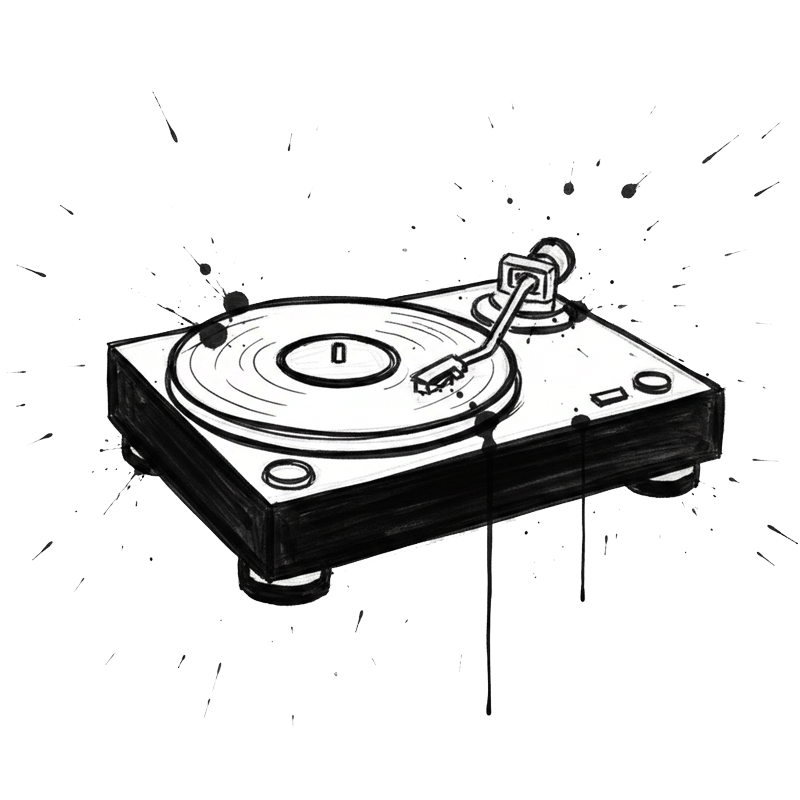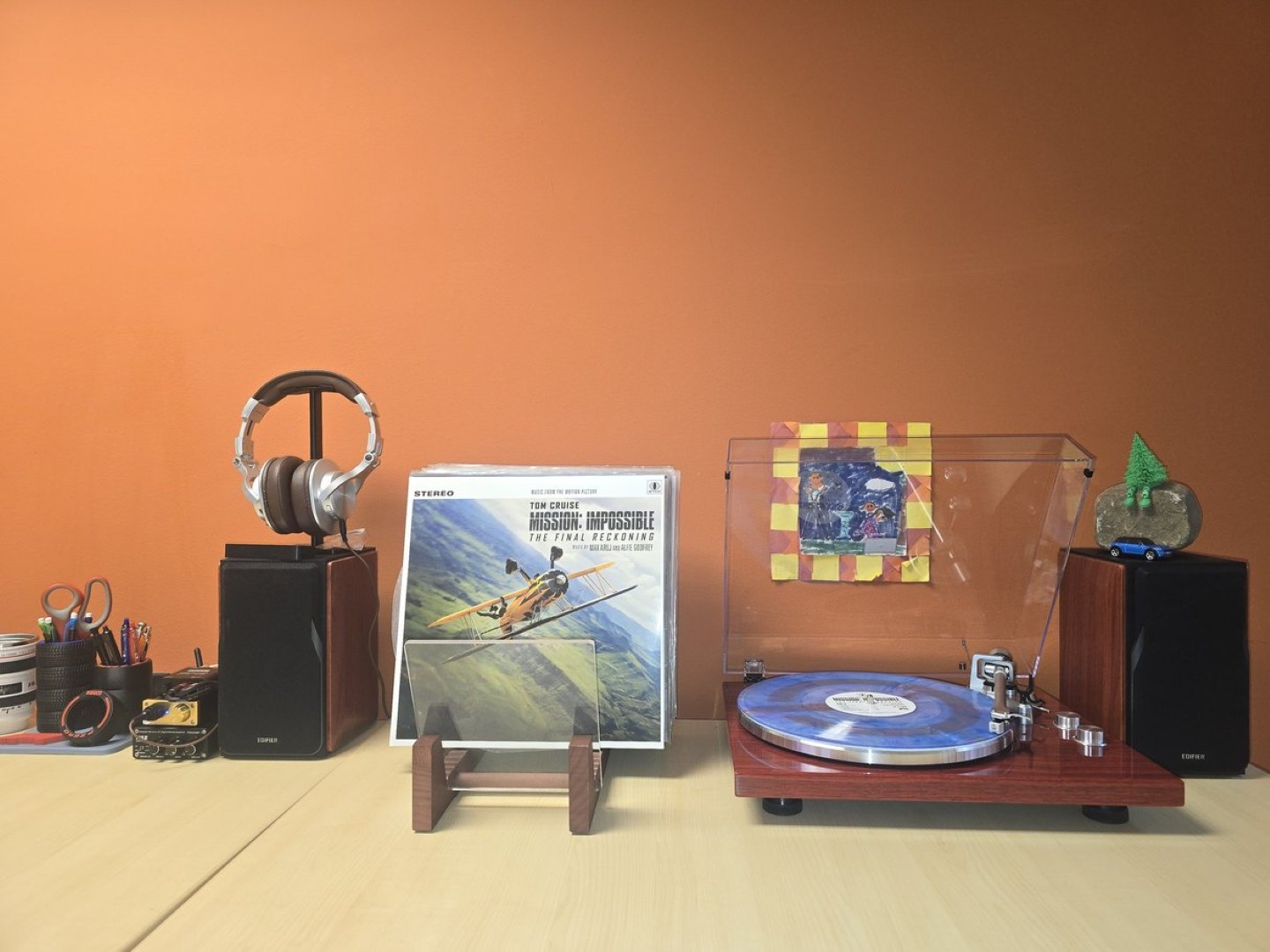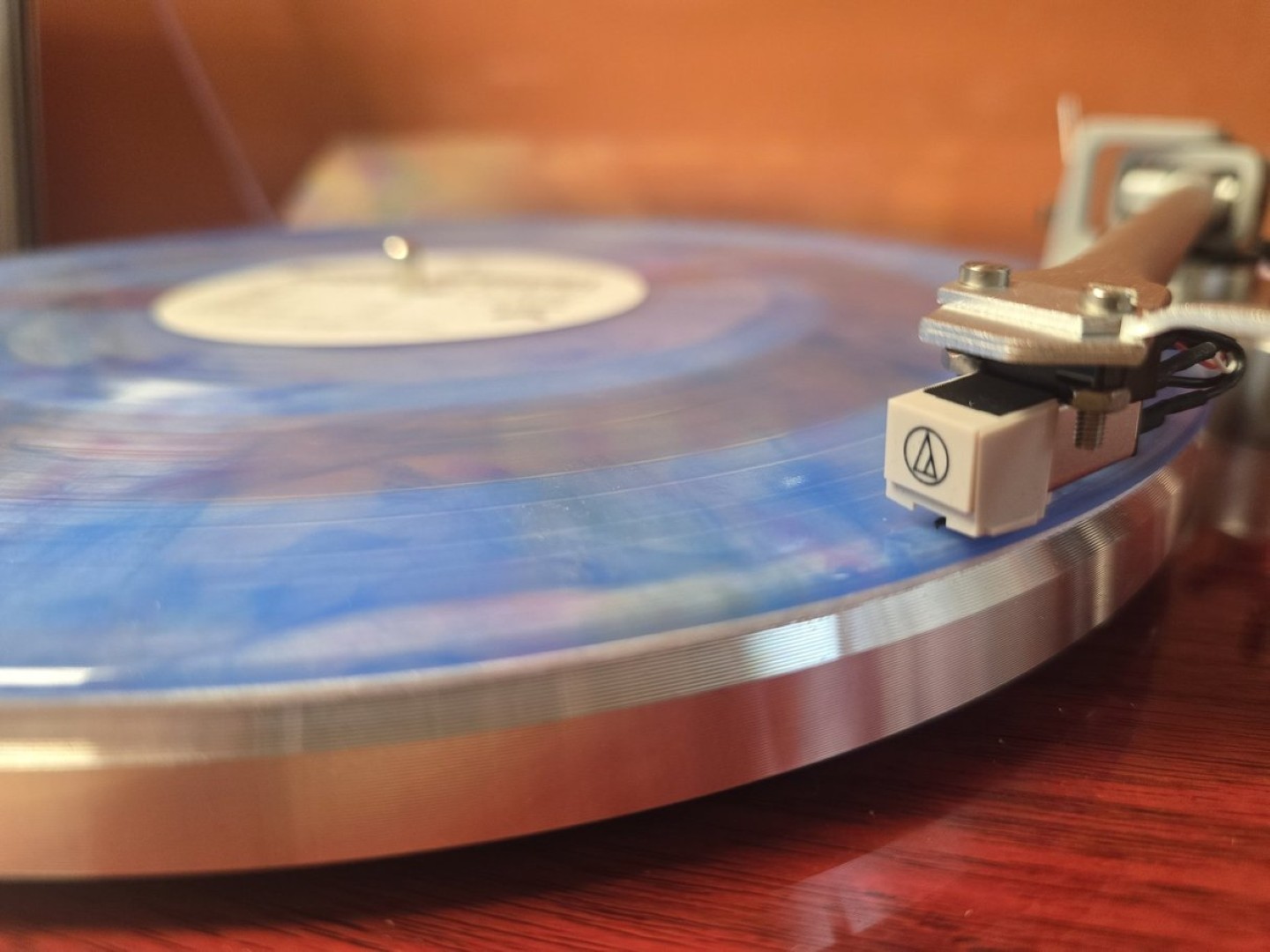vinyl
The Perfect Vinyl
Turntable
Setup

Home, Office, and Beyond
There’s something undeniably magical about dropping a needle onto vinyl. In an era of streaming services and infinite digital catalogs, vinyl records have experienced a remarkable resurgence. What once seemed destined for dusty thrift store bins has become the fastest-growing physical music format, with sales climbing year after year. But why? In a world where we can access any song in seconds, why are people investing in turntables, speakers, and record collections?
Disclosure: This post contains Amazon affiliate links. If you purchase through these links at no additional cost to you, I earn a small commission that helps support my creative works, including this blog, my AI newsletters, and podcast content. I only recommend products I genuinely use and believe in.



The Vinyl Resurgence:
Why Records Are Back
The comeback of vinyl isn’t nostalgia alone. It’s a deliberate rejection of convenience for quality. Streaming culture has given us unlimited access to music, but in doing so, it’s treated albums like buffets where individual songs are sampled and discarded. Vinyl forces intentionality. You can’t shuffle while making breakfast or endlessly skip ahead. You commit to an album, and the album commits to you.
Beyond philosophy, there’s tangible appeal. Vinyl records contain more audio information than most compressed digital files. The warmth and character many describe in vinyl sound comes from the analog format itself. The physical vibrations of the needle reading grooves create a listening experience that digital reproductions, no matter how high-fidelity, often struggle to match.
Why People Prefer the Vinyl Experience
Ask any vinyl enthusiast why they choose records over streaming, and you’ll hear recurring themes.
The Listening Experience: Vinyl demands presence. Without the ability to endlessly scroll through playlists, listeners sit with albums from start to finish. This creates a deeper engagement with an artist’s intended vision. Albums are sequenced with intention: the opening track, the flow, the closing statement. Streaming shuffled that away. Vinyl brings it back.

Album Art and Liner Notes: A 12-inch square canvas is a gallery. The typography, photography, artwork, and design on vinyl covers represent centuries of artistic tradition. Gatefolds open to reveal full track listings, credits, lyrics, and sometimes essays about the creative process. There’s tactile beauty in holding a record, reading the credits, seeing the artist’s vision presented as a complete work. Digital streaming reduced this to a thumbnail.
The Ritual: Pulling a record from the shelf, reading the spine, sliding the album out, examining both sides of the cover, placing it on the turntable, dropping the needle. It’s ceremonial. In our lives of infinite choice and immediate gratification, this ritual is grounding. It’s presence in a distracted world.
Collectibility: Vinyl collecting is experiencing a true renaissance. Limited editions, colored variants, reissues of classic albums on 180-gram audiophile pressings. Collecting vinyl feels meaningful in ways streaming playlists never could.

Building Your Vinyl Setup:
The Components That Matter
Creating the perfect turntable setup requires understanding the chain: turntable → preamp/receiver → amplifier → speakers. Each component matters, and each can be tailored to your space and listening preferences.
The turntable itself is foundational. You need something with good tracking force, minimal wow and flutter, and ideally a built-in preamp for flexibility. Quality speakers are non-negotiable, they’re what you actually hear. An amplifier drives those speakers with clean power. A receiver can integrate everything. And cables, often overlooked, should be of decent quality to avoid noise.
But the “perfect” setup is deeply personal. It depends on your room, your budget, your taste, and how you want to listen.
Wow and flutter are unwanted variations in the speed of a turntable’s platter. Wow refers to slow speed variations, while flutter describes rapid ones. Together, they cause pitch instability that degrades the listening experience.

My Home Setup:
The Reference System
My home turntable setup is my centerpiece listening experience. It’s the system I return to when I want to really hear my music.
The Turntable: I’m using the Fluance RT85 Reference High Fidelity Vinyl Turntable with Ortofon 2M Blue Cartridge (https://amzn.to/4oOtMaf). This turntable punches well above its price point with an acrylic platter, speed control motor, high-mass MDF wood plinth, and exceptional vibration isolation. The Ortofon 2M Blue cartridge is particularly noteworthy. It’s known for delivering detailed, warm playback that brings out the best in quality vinyl pressings. It’s the foundation of everything else.

The Amplification: To handle the turntable signal, I’ve paired it with the Fluance PA10 High Fidelity Phono Preamplifier (https://amzn.to/4i6wy86). This dedicated preamp provides pristine signal conversion with RIAA equalization, allowing me to bypass any mediocre built-in preamps and send a clean, amplified signal directly to my amplifier. The PA10 achieves incredibly low 0.5 dB RIAA deviation and keeps distortion ultra-low for exceptional clarity.
I’ve also integrated the Onkyo TX-SR393 5.2 Channel AV Receiver (https://amzn.to/3X7R0Mf). This is a full-featured home theater receiver with much more flexibility than a simple stereo amplifier. It delivers 80 watts per channel at 8 ohms with authentic high-current analog amps backed by a custom transformer. It supports Dolby Atmos and DTS:X for immersive surround sound, handles 4K/60p and HDR video passthrough, and includes six HDMI inputs plus Zone B line-out for distributing audio to other rooms. It serves as the central hub for my system, providing routing flexibility for both audio and video sources while delivering enough power to drive passive speakers with authority.
The Speakers: My speaker choice is critical to the home system’s character. I’m using the Jamo S 803 Bookshelf Speakers (https://amzn.to/486zX26) as my primary monitors. These two-way speakers feature a 1” soft-dome tweeter for smooth, refined high frequencies and a 5” aluminized polyfiber woofer for balanced, musical low end. The integrated WaveGuide focuses the high frequency sound for dynamic, true-to-life reproduction, while the front-firing slot port allows for better low frequency extension with flexible placement options. They’re compact yet deliver a satisfying soundstage with excellent clarity and handle everything from intimate vocals to complex orchestral passages with ease. The Jamo Studio speakers (https://amzn.to/3Ma7CAB) are my “center” channel speakers, and add additional full sound to our living room.
Jamo also has additional speaker options available in different finishes, available in a beautiful walnut finish (https://amzn.to/4o8vcLw) that might perfectly complement your room.
The result is a cohesive, room-filling sound that allows every pressing to breathe. Vocals are intimate, drums have weight, and the soundstage opens up. When I drop a needle on a great-sounding pressing, the entire system reveals the care taken in both the recording and the pressing.
This is the setup for serious listening sessions. It’s when the goal is experiencing music as an intentional art form.

My Office Setup:
Versatility and Efficiency
My office turntable setup is completely different. It needs to be compact, flexible, and capable of supporting both speaker and headphone listening without compromising either experience.
The Turntable: My office turntable is the 1 by ONE Belt Drive Turntable with Bluetooth Connectivity, USB Digital Output, and Built-in Phono Preamp (https://amzn.to/44cotch). This turntable features a statically balanced tonearm with anti-skating mechanism, powered by a DC motor with accurate speeds of 33 1/3 and 45 RPM. All of this provides the mechanical foundations for consistent audio quality.

What makes this particular turntable brilliant for an office setup is its connectivity flexibility. The Bluetooth connectivity is genuinely useful here. If you want to start listening to vinyl right away but can’t commit to a full wired speaker setup yet, you can pair this turntable with any Bluetooth speaker you already own. It’s a perfect stepping stone that lets you experience vinyl immediately while you build toward the ideal system. However, I’ll be completely honest: going full wired with a dedicated amplifier and passive speakers is the ultimate way to get the best listening experience. Once you hear vinyl through a proper wired setup, the sonic difference is remarkable. The details, the warmth, the depth all become more apparent.
The USB Digital Output feature is another killer advantage. You can connect this turntable to your computer via USB and encode your vinyl records into MP3 files for digitalized storage and playback on your computer, smartphone, or tablet. This means you can take your favorite albums with you on-the-go. Listen in your car, at the gym, or on a trip. Your physical collection stays pristine and protected, while you get portable access to all your music.
Speaker Support: For office speakers, I’m using the Edifier P17 Passive Bookshelf Speakers (https://amzn.to/4r8vqVz). These passive speakers feature a ¾ inch silk dome tweeter for clean, refined highs and a 4-inch driver for smooth, rich low-frequency sound. Each speaker has a bass reflex port that adds emphasis to the midwoofer, with high-quality crossovers ensuring balanced audio equalization. They’re finished in elegant wood accents that fit both contemporary and vintage aesthetics. Paired with the Pyle Home Channel Amplifier (https://amzn.to/3K8rUd8), they create a compact, focused system perfect for desktop or shelf placement while still delivering quality sound.
Headphone Infrastructure: This is where my office setup gets interesting. I’ve integrated a Headphone Amplifier Switcher (https://amzn.to/49ouu9l) that allows me to seamlessly switch between the speakers and the Audient Sono Headphone Amplifier (https://amzn.to/4i9jeQj), which provides exceptional headphone amplification for detailed listening when the office is busy or I want to disappear into a record without disturbing others.

Cables: Proper signal routing and quality cabling matter more in a multi-input setup. I’m using quality interconnects (https://amzn.to/49sQD6l) and additional specialty cables (https://amzn.to/48mpzEK) to ensure clean signal paths throughout the chain.
The office setup is about adaptability. Some days I want to share music through speakers while I work. Other days, I want to disappear into a record with headphones. This system accommodates both without compromise.

Your Own Setup:
A Few Principles
Whether you’re building a home system, an office system, or a bedroom setup, a few principles apply.
Start with the turntable. It’s the heart of the system, and quality here cascades through everything. You don’t need the most expensive option, but you need one you trust.
Invest in speakers. This is where your money has the most audible impact. Speakers are what you actually hear. Don’t settle here.
Choose an amplifier and receiver that match your needs. A simple integrated amplifier is perfect for a straightforward stereo system. A receiver offers more flexibility. Both can sound excellent.

Don’t ignore cables. Quality interconnects prevent noise and preserve the signal from turntable to speaker. This is an area where modest investment yields real results.
Size your system to your room. A compact office system doesn’t need the same power as a living room system. Match your setup to your space and listening habits.
Most importantly, build a system that makes you want to listen. The perfect setup is the one that gets you to pull records off the shelf and experience them as complete works of art, the way they were intended to be heard.

The
Future of Vinyl
Vinyl isn’t going anywhere. Every year brings new pressing plants opening, new artists releasing on vinyl, and new listeners discovering the format. It’s not about rejecting modern technology. It’s about choosing intentionality. It’s about reclaiming the album as an artistic statement and our listening as a focused, present practice.
Your vinyl setup, whether it’s a simple turntable and a pair of powered speakers or a component-based system like my home rig, is more than a playback system. It’s a statement about how you want to experience music.
In a world optimized for distraction, vinyl remains gloriously unoptimized for convenience. And that’s exactly why it’s worth it.
Read what I have to say about AI on my Substack.